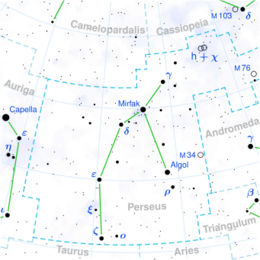Astronomy:5 Persei
| Observation data Equinox J2000.0]] (ICRS) | |
|---|---|
| Constellation | Perseus |
| Right ascension | 02h 11m 29.19322s[1] |
| Declination | +57° 38′ 43.9634″[1] |
| Apparent magnitude (V) | +6.35[2] |
| Characteristics | |
| Spectral type | B5 Ia[3] |
| U−B color index | −0.45[2] |
| B−V color index | +0.33[2] |
| Variable type | suspected[4] |
| Astrometry | |
| Radial velocity (Rv) | −34.1±0.9[5] km/s |
| Proper motion (μ) | RA: −0.540[1] mas/yr Dec.: −0.675[1] mas/yr |
| Parallax (π) | 0.4174 ± 0.0397[1] mas |
| Distance | 2950+388 −340[6] pc |
| Absolute magnitude (MV) | −6.7[7] |
| Details | |
| Radius | 79.93+5.89 −5.38[1] R☉ |
| Luminosity | 83,000[8] L☉ |
| Surface gravity (log g) | 2.00[8] cgs |
| Temperature | 15,000[8] K |
| Rotational velocity (v sin i) | 30[8] km/s |
| Other designations | |
| Database references | |
| SIMBAD | data |
5 Persei is a star in the northern constellation of Perseus located around 2,950 parsecs (9,600 ly) away from the Sun.[6] It is part of the Perseus OB1 stellar association and lies near the Double Cluster. This object is near the lower limit of visibility to the naked eye with an apparent visual magnitude of +6.35.[2] It is moving closer to the Earth with a heliocentric radial velocity of −34 km/s.[5]

This is a blue supergiant of spectral type B5 Ia; a massive star that has used up its core hydrogen and expanded into a very luminous star. It has an effective temperature around 15,000 K and is radiating 83,000 times the Sun's luminosity.[8] Several studies of 5 Persei have detected possible small amplitude variations. In 1983, an amplitude of 0.045 magnitudes was measured with a possible period of eight days.[7] An analysis of Hipparcos photometry showed an amplitude of 0.0168 magnitudes and a period of 2.65 days. The statistical signal was strong enough for the variability to be very likely, but 5 Persei has not formally been catalogued as a variable star.[11]
5 Persei has two nearby companions, a 12th magnitude star 5.7 arc-seconds away and a 13th magnitude star one arc-minute away.[12]
References
- ↑ 1.0 1.1 1.2 1.3 1.4 1.5 Brown, A. G. A. (August 2018). "Gaia Data Release 2: Summary of the contents and survey properties". Astronomy & Astrophysics 616: A1. doi:10.1051/0004-6361/201833051. Bibcode: 2018A&A...616A...1G. Gaia DR2 record for this source at VizieR.
- ↑ 2.0 2.1 2.2 2.3 Ducati, J. R. (2002). "VizieR Online Data Catalog: Catalogue of Stellar Photometry in Johnson's 11-color system". CDS/ADC Collection of Electronic Catalogues 2237: 0. Bibcode: 2002yCat.2237....0D.
- ↑ Grenier, S.; Baylac, M.-O.; Rolland, L.; Burnage, R.; Arenou, F.; Briot, D.; Delmas, F.; Duflot, M. et al. (1999). "Radial velocities. Measurements of 2800 B2-F5 stars for HIPPARCOS". Astronomy and Astrophysics Supplement 137 (3): 451. doi:10.1051/aas:1999489. Bibcode: 1999A&AS..137..451G.
- ↑ Samus, N. N. et al. (2017). "General Catalogue of Variable Stars". Astronomy Reports. 5.1 61 (1): 80–88. doi:10.1134/S1063772917010085. Bibcode: 2017ARep...61...80S.
- ↑ 5.0 5.1 Gontcharov, G. A. (November 2006). "Pulkovo Compilation of Radial Velocities for 35495 Hipparcos stars in a common system". Astronomy Letters 32 (11): 759–771. doi:10.1134/S1063773706110065. Bibcode: 2006AstL...32..759G.
- ↑ 6.0 6.1 Galazutdinov, G.; Strobel, A.; Musaev, F. A.; Bondar, A.; Krełowski, J. (2015). "The Structure and Kinematics of the Galaxy Thin Gaseous Disk Outside the Solar Orbit". Publications of the Astronomical Society of the Pacific 127 (948): 126. doi:10.1086/680211. Bibcode: 2015PASP..127..126G.
- ↑ 7.0 7.1 Percy, J. R.; Welch, D. L. (1983). "Photometric variability of B- and A-type supergiants". Astronomical Society of the Pacific 95: 491. doi:10.1086/131198. Bibcode: 1983PASP...95..491P.
- ↑ 8.0 8.1 8.2 8.3 8.4 McErlean, N. D.; Lennon, D. J.; Dufton, P. L. (1999). "Galactic B-supergiants: A non-LTE model atmosphere analysis to estimate atmospheric parameters and chemical compositions". Astronomy and Astrophysics 349: 553. Bibcode: 1999A&A...349..553M.
- ↑ "5 Per". SIMBAD. Centre de données astronomiques de Strasbourg. http://simbad.u-strasbg.fr/simbad/sim-basic?Ident=5+Per.
- ↑ "Light Curve". ESA. https://www.cosmos.esa.int/web/hipparcos/java-tools/light-curve.
- ↑ Koen, Chris; Eyer, Laurent (2002). "New periodic variables from the Hipparcos epoch photometry". Monthly Notices of the Royal Astronomical Society 331 (1): 45–59. doi:10.1046/j.1365-8711.2002.05150.x. Bibcode: 2002MNRAS.331...45K.
- ↑ Mason, Brian D.; Wycoff, Gary L.; Hartkopf, William I.; Douglass, Geoffrey G.; Worley, Charles E. (2001). "The 2001 US Naval Observatory Double Star CD-ROM. I. The Washington Double Star Catalog". The Astronomical Journal 122 (6): 3466. doi:10.1086/323920. Bibcode: 2001AJ....122.3466M.
 |

